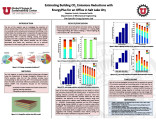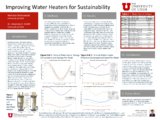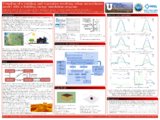|
|
Creator | Title | Description | Subject | Date |
| 1 |
 |
Bianchi, Carlo | Energy demands for commercial buildings with climate variability based on emission scenarios | The impacts of a changing climate are wide-ranging in both impact and scope. This paper investigates the effect that realistic climate variability would have on building energy demands in Salt Lake City, UT to inform planning for air quality impacts. Energy demand scenarios were derived using climat... | BEM; EnergyPlus; Emissions; Climate; Energy | 2017 |
| 2 |
 |
Tran, Thomas T.D. | Thermoeconomic analysis of residential rooftop photovoltaic systems with integrated energy storage and resulting impacts on electrical distribution networks | This paper investigates residential rooftop photovoltaic (PV) systems for long-term thermoeconomic benefits from PV homeowners' perspectives and for impacts on the electrical distribution network from grid operators' perspectives. The costs of generating electricity from grid-connected PV systems ar... | Rooftop PV; Net Metering; Distribution Network; Energy storage; LCOE | 2018-07-07 |
| 3 |
 |
Lucich, Stephen; Smith, Amanda | Estimating building CO2 emissions reductions with EnergyPlus | The aim of this research is to investigate the potential to reduce greenhouse gas (GHG) emissions from the buildings sector in the Salt Lake Valley by altering the operational strategies of existing buildings. Air quality efforts typically focus on reducing emissions from transportation and industri... | Building energy modeling, Energy efficiency, HVAC, Greenhouse gas emissions | 2014-02-07 |
| 4 |
 |
Malinowski, Nicholas | Improving water heaters for sustainability | Buildings use about 40% of the total U.S. energy demand. Water heaters provide hot water for a variety of building uses including sinks, showers, dishwashers, washing machines, and space heating. Water heaters are the second most energy intensive appliances in a common household. Typically a home... | Water heaters; Energy efficiency; Electricity; Emissions; Natural gas | 2018 |
| 5 |
 |
Bianchi, Carlo | Coupling of building and vegetation resolving urban microclimate model with a building energy simulation program | The objective of this work is to develop and validate a coupled fast-running Building Energy Modeling/Microclimate model for use in developing site-specific design strategies which minimize energy and water use All the micro-climate variables affecting the building energy consumption, such as solar ... | Building energy modeling; Urban; Microclimate; Simulation; Energy; Environment | 2018-08 |
| 6 |
 |
Normann, Richard A.; Johansson,Torbjorn; Abbasi, Masoud; Huber, Robert J. | Three-dimensional architecture for a parallel processing photosensing array | A three-dimensional architecture for a photosensing array has been developed. This silicon based architecture consists of a 10 x 10 array of photosensors with 80 microns diameter, through chip interconnects to the back side of a 500 microns thick silicon wafer. Each photosensor consists of a 300 x 3... | Retina; Optics; Silicon; Photosensing | 1992 |
| 7 |
 |
Tran, Thomas T. D. | System scaling approach and thermoeconomic analysis of a pressure retarded osmosis system for power production with hypersaline draw solution: A Great Salt Lake study | Osmotic power with pressure retarded osmosis (PRO) is an emerging renewable energy option for locations where fresh water and salt water mix. Energy can be recovered from the salinity gradient between the solutions. This study provides a comprehensive feasibility analysis for a PRO power plant in a ... | Pressure retarded osmosis; Power generation; Renewable energy; Hydroelectric; Levelized cost | 2017-06 |
| 8 |
 |
Gale, Bruce K. | Cyclical magnetic field flow fractionation | In this study, a new magnetic field flow fractionation (FFF) system was designed and modeled by using finite element simulations. Other than current magnetic FFF systems, which use static magnetic fields, our system uses cyclical magnetic fields. Results of the simulations show that our cyclical mag... | | 2012-01-01 |
| 9 |
 |
Rahman, Aowabin | Deep recurrent neural networks for building energy prediction | This poster illustrates the development of a deep recurrent neural network (RNN) model using long-short-term memory (LSTM) cells to predict energy consumption in buildings at one-hour time resolution over medium-to-long term time horizons ( greater than or equal to 1 week). | Machine learning; Energy; Building energy modeling; Deep learning; Recurrent neural networks; Prediction | 2017-01-13 |
| 10 |
 |
Gale, Bruce K. | Microfluidic devices for rapid and sensitive identification of organisms | Microfluidic devices for rapid and highly sensitive detection of living organisms were developed for two applications. First, a zebrafish embryo genotyping system was developed and shown to be able to genotype embryos in the first 48 hours of the embryos life without damaging the embryos in any a... | | 2014-01-01 |
| 11 |
 |
Gale, Bruce K. | New approaches to bridge nerve gaps: Development of a novel drug-delivering nerve conduit | Contemporary bridging techniques for repairing nerve gaps caused by trauma require autologous nerve grafts, which are difficult to harvest and handle and result in significant donor site deficit. Several nerve conduits with axon growth-enhancing potential have been proposed, developed and tested ove... | | 2012-01-01 |
| 12 |
 |
Rahman, Aowabin | Predicting electricity consumption for commercial and residential buildings using deep recurrent neural networks | This paper presents a recurrent neural network model to make medium-to-long term predictions, i.e. time horizon of ≥ 1 week, of electricity consumption profiles in commercial and residential buildings at one-hour resolution. Residential and commercial buildings are responsible for a significant fr... | Building Energy Modeling; Machine learning; Recurrent neural networks; Deep learning; Electric load prediction | 2017 |
| 13 |
 |
Didier, Richard C. | Linking microclimate and energy use with a low cost wall mounted measurement system | Urban microclimate plays a critical role in overall urban energy demand and efficiency. At the building scale, energy use and internal conditions are directly impacted by local microclimate. The direct link between building energy use and local microclimate is through building envelope heat fluxes. ... | Microclimate; Energy; Temperature; Humidity; Arduino; EnergyPlus | 2016-06 |
| 14 |
 |
Adams, Daniel | Microbial production of methane and carbon dioxide from lignite, bituminous coal, and coal waste materials | The aim of this study was to examine microbial methane and CO2 production from bituminous coal waste, lignite, and bituminous coal materials. Bituminous coal and coal waste material were obtained from a Utah mine and lignite was obtained from a commercially available North Dakota sample. Microbial p... | | 2012-01-01 |
| 15 |
 |
Horch, Kenneth W.; Lawrence, Steve M.; Dhillon, Gurpreet S. | Acute peripheral nerve recording characteristics of polymer-based longitudinal intrafascicular electrodes | We examined the recording characteristics of two different types of polymer-based longitudinal intrafascicular electrodes (LIFEs) in peripheral nerve: single-stranded (s-polyLIFEs) and multistranded (m-polyLIFEs). Recordings were also made from Pt-Ir wire-based electrodes (PtIrLIFEs) as a control. T... | Sciatic Nerve; Intrafascicular Electrodes, Peripheral Nerve Recording | 2004 |
| 16 |
 |
Colter, Jourdan; Wirostko, Barbara; Coats, Brittany | Finite element design optimization of hyaluronic acid-based hydrogel drug delivery device for improved retention | Drug-loaded hydrogel devices are emerging as an effective means of localized and sustained drug delivery for the treatment of corneal conditions and injuries. One such device uses a novel, thiolated crosslinked carboxymethylated, hyaluronic acid-based hydrogel (CMHA-S) film to deliver drug to the oc... | Ocular drug delivery; CMHA-S; antibiotics; ophthalmology; computation | 2018 |
| 17 |
 |
Adams, Daniel | Micromechanical modeling of high energy composites | High-energy polymer-binded explosives (PBXs) are composed of high-energy crystaline particles and a rubbery binder. The volume fraction of particles is approximately 92 percent. The high-energy particles have a Young's modulus that is three orders of magnitude higher than that of the binder. Eff... | | 2000 |
| 18 |
 |
Smith, Amanda D. | Modeling two-phase flow and vapor cycles using the generalized fluid system simulation program | This work presents three new applications for the general purpose fluid network solver code GFSSP developed at NASA's Marshall Space Flight Center: (1) cooling tower, (2) vapor-compression refrigeration system, and (3) vapor-expansion power generation system. These systems are widely used across eng... | Modeling; Fluid systems; Cooling tower; Vapor compression refrigeration, vapor power cycle | 2017-09 |
| 19 |
 |
Normann, Richard A.; Abbasi, Masoud; Johansson,Torbjorn | Silicon carbide enhanced thermomigration | The widespread acceptance of thermomigration technology to produce through-chip interconnects has been impaired by (i) a random walk of the Si-Al liquid eutectic inclusion as it traverses the wafer, and (ii) a ?surface barrier? which allows thermomigration of only relatively large inclusions. In ... | Silicon Dioxide; Thermometers; Transducers; Thermomigration Technology; Infrared Lamps | 1992 |
| 20 |
 |
Rahman, Aowabin | Predicting fuel consumption for commercial building with machine learning algorithms | This paper presents a modeling framework that uses machine learning algorithms to make longterm, i.e. one year-ahead predictions, of fuel consumption in multiple types of commercial prototype buildings at one-hour resolutions. Weather and schedule variables were used as model inputs, and the hourly ... | Building energy modeling; Machine learning; Prediction; Heating load; Data-driven modeling | 2017-08 |
| 21 |
 |
Thomas, Tran T. D. | Evaluation of renewable energy technologies and their potential for technical integration and cost-effective use within the U.S. energy sector | Energy demands, environmental impacts of energy conversion, and the depletion of fossil; fuels are constant topics of discussion in the energy industry. Renewable energy technologies; have been proposed for many years to address these concerns. However, the transformation; from traditional methods o... | Renewable energy; Power generation; Electrical grid; Emerging energy systems; System integration | 2017-07 |
| 22 |
 |
Legorburu, Gabriel | Energy modeling framework for optimizing heat recovery in a seasonal food processing facility | Societal, cultural and economic factors are driving food processors to reduce energy consumed per unit mass of food. This presents a unique problem because time variant batch processing using low to medium grade heat is common in food production facilities. Heat recovery methods may be implemented b... | Energy efficiency; Food industry; Heat recovery; Optimization; Simulation | 2018-07-20 |
| 23 |
 |
Horch, Kenneth W.; Dhillon, Gurpreet S. | Direct neural sensory feedback and control of a prosthetic arm | Evidence indicates that user acceptance of modern artificial limbs by amputees would be significantly enhanced by a system that provides appropriate, graded, distally referred sensations of touch and joint movement, and that the functionality of limb prostheses would be improved by a more natural co... | Peripheral Nerve Implant; Prosthetic Limb Control; Sensory Feedback | 2005-12 |
| 24 |
 |
Roundy, Shadrach J. | A cost-effective planar electromagnetic energy harvesting transducer | This paper presents a planar multi-pole electromagnetic energy harvesting transducer. We report on the design, manufacture, and performance results of integrated devices based on this transducer. The transducer leverages recent advancements in the manufacture of multi-pole magnets and can be impleme... | | 2012-01-01 |
| 25 |
 |
Guilkey, James Edward | Improved contact algorithm for the material point method and application to stress propagation in granular material | Contact between deformable bodies is a difficult problem in the analysis of engineering systems. A new approach to contact has been implemented using the Material Point Method for solid mechanics, Bardenhagen, Brackbill, and Sulsky (2000a). Here two improvements to the algorithm are described. The f... | Contact algorithm; Material point method; Wave propagation; Granular material; Solid mechanics | 2001 |

























